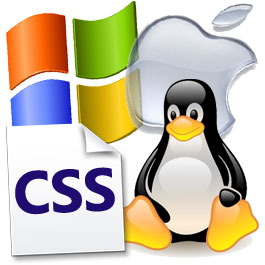 One of the lesser-known features of CSS2.1 is the ability to define fonts and colors that are in use by the underlying Operating System theme. This can be useful in situations when you require tighter OS integration, e.g. HTML help files, Adobe AIR or perhaps offline web applications.
Before we begin, there are a few caveats:
One of the lesser-known features of CSS2.1 is the ability to define fonts and colors that are in use by the underlying Operating System theme. This can be useful in situations when you require tighter OS integration, e.g. HTML help files, Adobe AIR or perhaps offline web applications.
Before we begin, there are a few caveats:
- Do not rely on these properties working in all OS/browser combinations. If your application must work in Opera on BeOS, then I’d recommend you test it first!
- The properties have been deprecated in CSS3 in favor of the appearance value type (although browser support is extremely limited at this time).
- There is nothing to prevent the user defining unusual, clashing, or ugly color schemes in their OS. Pages will reflect their choices — not your designer’s.
System Fonts
System fonts are assigned using the ‘font’ property. Note that the family, size, and style are all assigned as appropriate, e.g.
body
{
font: caption;
}
| Property | Description | Example |
|---|---|---|
| caption | Controls font (buttons, drop-downs, etc.) | ABC abc 123 |
| icon | Icon label font | ABC abc 123 |
| menu | Menu font | ABC abc 123 |
| message-box | Dialog box font | ABC abc 123 |
| small-caption | Small control labels | ABC abc 123 |
| status-bar | Status bar font | ABC abc 123 |
System Colors
System colors can be assigned to to any property that expects a color value, e.g.
body
{
color: WindowText;
background-color: Window;
border: 2px solid ActiveBorder;
}
| Property | Description | Example |
|---|---|---|
| ActiveBorder | Active window border | |
| ActiveCaption | Active window caption | |
| AppWorkspace | Background color of multiple document interface | |
| Background | Desktop background | |
| ButtonFace | Face color for 3D display elements | |
| ButtonHighlight | Dark shadow for 3D display elements (facing away from light) | |
| ButtonShadow | Shadow color for 3D display elements | |
| ButtonText | Text on push buttons | |
| CaptionText | Text in caption, size box, and scrollbar arrow box | |
| GrayText | Grayed (disabled) text (#000 if not supported by OS) | |
| Highlight | Item(s) selected in a control | |
| HighlightText | Text of item(s) selected in a control | |
| InactiveBorder | Inactive window border | |
| InactiveCaption | Inactive window caption | |
| InactiveCaptionText | Color of text in an inactive caption | |
| InfoBackground | Background color for tooltip controls | |
| InfoText | Text color for tooltip controls | |
| Menu | Menu background | |
| MenuText | Text in menus | |
| Scrollbar | Scroll bar gray area | |
| ThreeDDarkShadow | Dark shadow for 3D display elements | |
| ThreeDFace | Face color for 3D display elements | |
| ThreeDHighlight | Highlight color for 3D display elements | |
| ThreeDLightShadow | Light color for 3D display elements (facing the light) | |
| ThreeDShadow | Dark shadow for 3D display elements | |
| Window | Window background | |
| WindowFrame | Window frame | |
| WindowText | Text in windows |
Frequently Asked Questions about CSS System Styles
What are CSS System Styles and why are they important?
CSS System Styles are a set of predefined styles that are native to the operating system or browser. They are important because they allow developers to create web pages that can adapt to the user’s system preferences, providing a more personalized and accessible user experience. For instance, if a user has set their system to dark mode, a web page styled with CSS System Styles can automatically adjust to match this setting.
How do CSS System Styles differ from regular CSS styles?
Regular CSS styles are defined by the developer and remain the same regardless of the user’s system settings. On the other hand, CSS System Styles are dynamic and can change based on the user’s system preferences. This makes them a powerful tool for creating adaptable and user-friendly web designs.
How can I use CSS System Styles in my web design?
CSS System Styles can be used in your CSS code just like any other style. The main difference is that instead of specifying a fixed value, you use a system color keyword. For example, to set the background color to match the user’s system window background, you would use the code background-color: Window;.
What are some examples of CSS System Styles?
There are many different CSS System Styles that correspond to various aspects of the user’s system. Some examples include ButtonFace for the face color of a button, Highlight for the color of selected text, and WindowText for the color of text in windows.
Are CSS System Styles supported by all browsers?
CSS System Styles are widely supported by most modern browsers, including Chrome, Firefox, Safari, and Edge. However, it’s always a good idea to test your web design in multiple browsers to ensure compatibility.
Can I use CSS System Styles with other CSS styles?
Yes, CSS System Styles can be used in combination with other CSS styles. This allows you to create a design that is both adaptable and consistent with your brand.
How do CSS System Styles improve accessibility?
CSS System Styles improve accessibility by allowing web pages to adapt to the user’s system preferences. This can make it easier for users with visual impairments to navigate your site, as they can adjust their system settings to meet their needs.
Can I override CSS System Styles?
Yes, you can override CSS System Styles by specifying a different style in your CSS code. However, keep in mind that this will negate the adaptability benefits of using system styles.
Are there any drawbacks to using CSS System Styles?
One potential drawback to using CSS System Styles is that they can lead to inconsistent designs across different systems. However, this can be mitigated by using a combination of system styles and regular CSS styles.
Where can I learn more about CSS System Styles?
There are many resources available online for learning about CSS System Styles. Some recommended sites include the Mozilla Developer Network, W3C, and SitePoint.
Craig is a freelance UK web consultant who built his first page for IE2.0 in 1995. Since that time he's been advocating standards, accessibility, and best-practice HTML5 techniques. He's created enterprise specifications, websites and online applications for companies and organisations including the UK Parliament, the European Parliament, the Department of Energy & Climate Change, Microsoft, and more. He's written more than 1,000 articles for SitePoint and you can find him @craigbuckler.


